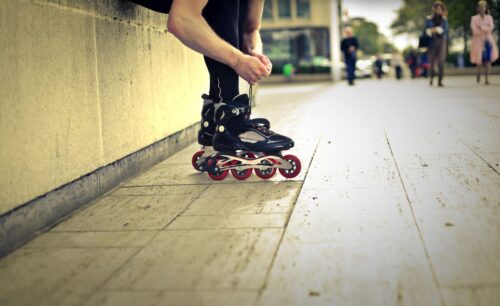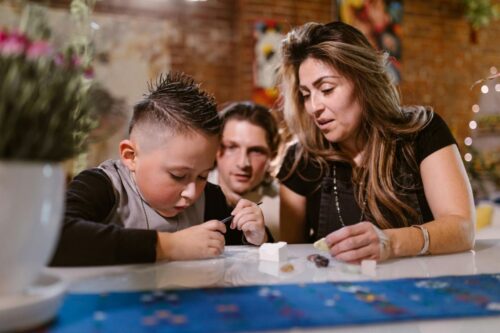Proprioception: The Correlation Between Poor Motor Skills and Autism
 Have you been called clumsy or do you struggle with coordination and balance? How is your handwriting? Have people called you out on your posture or gait when walking? While it isn’t always the case, a common co-occurring conditions that often accompanies autism is poor motor skills.
Have you been called clumsy or do you struggle with coordination and balance? How is your handwriting? Have people called you out on your posture or gait when walking? While it isn’t always the case, a common co-occurring conditions that often accompanies autism is poor motor skills.
While I haven’t thought about it before, I personally check a lot of those boxes, but as with others, my challenges with fine motor skills and gross motor skills combined is just part of my experience.
For example, I’m somewhat considered ambidextrous, and have switched hands repeatedly with how I use my eating utensils and even which hand I write with.
I’m told I have an awkward gait and sometimes an unusual posture. And I’ve struggled with buttoning things.
While annoying, I’ve totally adapted and have just attributed it to me being me. But is moving my body properly—as compared to others—an autistic thing or just a “me” thing? And is there anything to be done about it? That’s the bigger question.
As it turns out, one of the co-occurring conditions that often accompany autism is poor motor skills, as many (but not all) autistics have problems with moving their body properly.
Motor Skills and Developmental Milestones Explored
For many individuals on the autism spectrum, challenges with motor skills and body movements can be a very real part of their experience. While repetitive body movements like stimming are one aspect that is often discussed, there are other important motor differences that deserve more attention and understanding.
Issues with muscle coordination, balance, motor planning, and execution of movements are widespread yet frequently overlooked aspects of autism.
Poor muscle tone, balance issues, and troubles with coordination of movements are commonly reported among those on the spectrum. Simple tasks involving gross motor skills like walking, running, jumping, throwing or catching a ball, or using utensils can be extremely difficult.
 Performing a sequence of motions in the proper order may not come naturally. Basic actions that are second nature to most people require intense focus and effort (such as learning to ride a bike).
Performing a sequence of motions in the proper order may not come naturally. Basic actions that are second nature to most people require intense focus and effort (such as learning to ride a bike).
Struggles with fine and gross motor skills can make physical activities, sports, arts and crafts, handwriting, getting dressed, and other life activities exhausting ordeals.
The underlying neurological causes behind these motor differences in autism are not fully understood, but researchers point to several potential factors. It likely involves differences in the brain’s processing and integration of sensory information related to body movements and positions. Certain motor pathways and areas controlling motor skills may develop or function atypically in those on the spectrum.
There appears to be a disconnect between the brain properly mapping intentions for physical actions and then providing accurate instructions for the necessary muscle movements. Mixed signals between the brain, nerves, and muscles can result in movements being slower, less precise, poorly timed or less smoothly coordinated. This can manifest as clumsiness, rigidity, a hunched posture, or appearing perpetually unstable on one’s feet.
Proprioception: Being Aware of Your Body’s Movements
Many on the autism spectrum also experience challenges with proprioception, commonly defined as awareness of one’s body position and movements through subconscious perception of muscle/joint positions and movements.
Without proprioception, or an accurate internal sense of how their body is oriented and moving, it becomes extremely difficult to make adjustments and retrieve the learned motor patterns for common skills like walking normally or batting a baseball.
The degree of motor difficulties can span a wide range across the autism spectrum. For some, the issues may be barely noticeable outside of slight coordination problems.
Others may face profound challenges with primary motor skills like sitting upright, using utensils, getting dressed independently, or even issues with oral-motor deficits impacting speech (like apraxia) and swallowing abilities. There is a huge diversity in how motor challenges present themselves in autism.
With early intervention, identification of developmental milestones and any motor delays, and the right therapeutic support, many of these motor skill deficits can be managed or significantly improved over time. Occupational therapy helps those on the spectrum develop gross and fine motor skills (like threading a needle) through targeted activities and exercises that progressively build skills.
Physical therapy can improve core strength for poor muscle tone, balance, coordination, and overall body movements through specialized programs.
Body Awareness and Motor Skills Improvements
Practicing skills through purposeful repetition, scaffolding more complex actions out of mastered individual motions, utilizing adaptive equipment or techniques, and reinforcing established neural pathways related to movement can unlock new levels of ability and independence. Using pencil grips, weighted utensils, velcro clothing, and other adapted tools enable greater ease with various motor tasks.
 However, acquiring new motor skills is typically an arduous process for those on the spectrum that requires tremendous patience, explicit instruction, and an understanding of the need for accommodations.
However, acquiring new motor skills is typically an arduous process for those on the spectrum that requires tremendous patience, explicit instruction, and an understanding of the need for accommodations.
What may seem like a simple skill to most people is actually a monumental achievement resulting from dogged practice and support. Without the proper resources and therapeutic interventions, significant motor delays from poor muscle tone and other not achieving typical developmental milestones can persist into adulthood.
Beyond just difficulties mastering skills, there are social-emotional impacts as well. Frequent experiences of being clumsy, dropping objects, unusual gait patterns, looking awkward or uncoordinated, and struggling with physical activities can deeply affect self-esteem and lead to anxiety around trying new skills. This hesitancy and perfectionism can paradoxically reinforce motor issues through reduced opportunities to practice and exposure. Bullying and teasing from peers over poor motor skills and coordination is a tragically common experience.
For those on the autism spectrum, increased understanding and acknowledgement of the broad range of motor differences is so important, rather than focusing solely on self-stimulatory behaviors like stimming or rocking.
Proprioception and Fine and Gross Motor Skills Can Be Developed
With the proper resources, support systems, and overall societal patience, many on the autism spectrum can work to develop body movement abilities at their own pace. Occupational and physical therapists play a vital role in providing this therapeutic assistance. However, their expertise must be complemented by accommodations and understanding in other facets of life as well.
In educational settings, schools should make appropriate provisions to ensure students on the spectrum can fully participate in physical education classes, recess periods, arts/crafts lessons, and any activities requiring motor skills.
This may involve specialized equipment, modified rules, teacher’s aides for support, or adjusted curriculums for motor difficulties.
On the playground, coaching staff, teachers, and other students should be educated about not excluding or stigmatizing peers on the basis of motor skills development. Creating an environment of patience, positive reinforcement of effort, and access to desired activities in alternative forms is key.
For example, if a student faces obstacles participating in standard playground games, analogous modified games allowing their involvement should be offered as an option.
In adulthood, workplace accommodations and understanding from employers are essential for those on the spectrum experiencing motor skills challenges. Recognizing strengths and giving opportunities to leverage them is important, such as prioritizing cognitive abilities over manual dexterity for certain roles and responsibilities. Openness to utilizing assistive technologies, tools or utilities to aid with motor requirements is also valuable.
Impact on Social Situations and Developmental Milestones
Even social situations can be impacted, as difficulties with gestures, body language, and knitting motions into natural conversational flow can impede communication. Counsel on alternative non-verbal communication methods, or simply allowing time and space for those on the spectrum to find their words, can help tremendously.
 What may seem simple to others can be a struggle amounting to a hard-earned achievement for many on the autism spectrum. Movement and basic motor skills are a fundamental part of life that the non-autistic world largely takes for granted, yet they represent an aspect of a neurological difference that is often overlooked, minimized or misunderstood.
What may seem simple to others can be a struggle amounting to a hard-earned achievement for many on the autism spectrum. Movement and basic motor skills are a fundamental part of life that the non-autistic world largely takes for granted, yet they represent an aspect of a neurological difference that is often overlooked, minimized or misunderstood.
By spreading awareness and education about the realities of motor differences and proprioception experienced by many on the spectrum, more understanding, appropriate interventions, and deserved accommodations can be made available throughout all environments and age groups. Lack of motor skills should not equate to lack of potential in other areas.
With patience, compassion, and an open mindset to providing supportive resources rather than insisting on “normal” standards, the challenges of motor skills need not be limitations on living a fulfilling life for those with autism.
Autism in Adults: Living, Learning, and Overcoming Challenges for a Fulfilled Life
Autism in adults requires additional support and coping skills to achieve independence in today’s world.
Learn more about ways adults can live fulfilled lives and the challenges they face.
- 14 Practical Ways for Staying Motivated to Unlock Full Potential
- Autism and Independence: 7 Skills That Empower Individuals to Thrive
- Autism on the Brain: Unpacking the Meaning Behind Neurodiversity
- Autism Volunteer Opportunities: 5 Ways Helping Others Fosters Acceptance
- 8 Heartfelt Ways Autism Emotional Support Animals Transform Lives
- Are You An Adult With Autism? Here Are 6 Signs
- Autism After High School: Is College the Next Step?
- Autism vs Asperger’s Syndrome: What You Need to Know
- Autism Disclosure: Is Revealing Your Disorder Helpful or Hurtful?
- Work and Autism: What Employers Should Know About Hiring People with Neurodiversity
- Drivers with Autism Can Achieve Success Behind the Wheel
- Growing Up Autistic: How I Overcame Challenges and Now Thrive